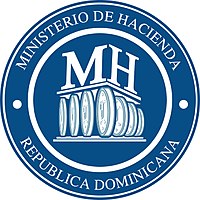
Summary
The Ministry of Finance (Spanish: Ministerio de Hacienda), also Ministry of Internal Revenue, of the Dominican Republic is the government institution in charge of preparing, executing and evaluating the coutry's fiscal policies, including national income, expenses and finance and securing its sustainability in relation to the economical policies. Other functions are to propose fiscal and customs legislation, regulate loans' authorization and negotiation, approve public contracting, and periodically prepare the state of the budget, finance and economy.
| Ministerio de Hacienda | |
 Logo of the Ministry of Finance between 2010-2020 | |
| Agency overview | |
|---|---|
| Formed | November 14, 1844 |
| Jurisdiction | |
| Headquarters | Av. México, Santo Domingo |
| Annual budget | RD$ 20,222,491,904.92 (2021)[1] |
| Minister responsible |
|
| Website | https://www.hacienda.gob.do/ |
It was established on the first Dominican Constitution of 1844 as the Secretary of State of Finance and Trade (Secretaría de Estado de Hacienda y Comercio). Its headquarters are located at Santo Domingo. Since August 16, 2020, its Minister is José Manuel Vicente.[3]
History edit
The origin of this Ministry can be found on the first Dominican Constitution, signed on November 6, 1844. This document specified that:
There will be four Ministers-Secretaries of State and of the following Departments: first, of Justice and Public Instruction; second, of the Interior and Police; third, of Finance and Trade; fourth of War and Navy.
— Constituent Assembly, Constitution of San Cristóbal, Title III, Chapter II, Section II, Art. 109[4]
A few days later, on November 14, 1844 the office was officially created as the Secretary of State of Finance and Trade (Secretaría de Estado de Hacienda y Comercio), being its first ministre-secretary Ricardo Miura.[5] The office was also held in its early days by national hero Ramón Matías Mella, as well as José Manuel Caminero, Jacinto de la Concha and José Joaquín Puello.
During the Second Republic (1865-1916), this institution saw several financial crisis that damaged the politics of the Dominican Republic. President Ulises Heureaux's government was characterized by the unsupported issue of banknotes and the unmeasured debt to foreign companies. This situation led to the Dominico-American Convention of 1907 during the presidency of Ramón Cáceres, which ceded Dominican customs to the United States. This eventually led to the American occupation of the Dominican Republic (1916-1924). During this period, the institution is renamed Secretary of Treasury and Finance (Secretaría de Estado del Tesoro y Hacienda).
During the Third Republic (1924-1965), this office was renamed several times, being known for a time as Secretary of State of Finance, Labour and Communications (Secretaría de Estado de Hacienda, Trabajo y Comunicaciones). At the start of the Fourth Republic in 1965, it was known as Secretary of State of Finance (Secretaría de Estado de Finanzas).
On 2006, Law no. 494-06 reorganized the institution, which was renamed from Finanzas to Hacienda, which in English can be translated as both finance or internal revenue.[6] At the same, the government created a new departement, the Secretary of State of Economy, Planning and Development (Secretaría de Estado de Economía, Planificación y Desarrollo).
It adopted its current name, Ministry of Finance or Internal Revenue (Ministerio de Hacienda), after the 2010 Constitutional reform and the subsequent Decree no. 56-10 which changed the names of all government agencies.[7]
Internal structure edit
As all other Ministries of the Dominican Republic, the Ministry of Finance is subdivided into vice-ministries.[8] These are:
- Technical-Administrative Vice-ministry
- Vice-ministry of Budget, Accounting and Assets
- Vice-ministry of State Assets
- Vice-ministry of the Treasury
- Vice-ministry of Public Credit
- Vice-ministry of Fiscal Policy
Affiliated agencies edit
As fiscal regulator, the Ministry of Finance has a great number of decentralized institutions.[9] Some of these are:
- Superintendency of Insurance
- General Office of Customs (DGA)
- General Office of Internal Revenue (DGII)
- General Office of National Cadastre
- General Office of Budget
- General Office of Public Credit
- Bank of Reserves of the Dominican Republic (BanReservas)
- National Treasury
- National Lottery
- Savings Fund for Workers and Monte de Piedad
List of renowned secretaries and ministers edit
- Ramón Matías Mella, 1849–1850
- Manuel María Gautier, 1876
- Francisco Gregorio Billini, 1878
- Arturo Grullón, 1912
- Francisco J. Peynado, 1916
- Eladio Sánchez, 1922–1923
- Tulio Manuel Cestero, 1933
- Rafael Brache, 1933–1934
- Manuel de Jesús Troncoso, 1944–1945
- Victor Garrido, 1947–1949
- José Manuel Machado, 1961–1962
- Jacobo Majluta, 1963
- José Rafael Abinader, 1965
- José Rafael Abinader, 1982–1984
- Licelot Marte de Barrios, 1990–1993
- Daniel Toribio, 1996–2000; 2011-2012
- Simón Lizardo Mézquita, 2012–2016
- Donald Guerrero, 2016–2020
- José Manuel Vicente, 2020–
See also edit
References edit
- ^ "Datos de la Ejecución Presupuestaria" (PDF). Dirección General de Presupuesto (in Spanish). 2022-12-30. Retrieved 2023-02-15.
- ^ "Despacho del Ministro". Ministerio de Hacienda (in Spanish). Retrieved 2023-02-19.
- ^ "Decreto no. 324-20". Presidencia de la República Dominicana (in Spanish). 2016-08-16. Retrieved 2023-02-15.
- ^ "Constitution 1844". Scribd. Retrieved 2023-02-19.
- ^ "Historia". Ministerio de Hacienda. Retrieved 2023-02-19.
- ^ Congress of the Dominican Republic (2006-12-27). "Ley no. 494-06 de organización de la Secretaría de Estado de Hacienda" (PDF). Ministerio de Hacienda (in Spanish). Retrieved 2023-02-19.
- ^ "Decreto no. 56-10" (PDF). International Labour Organization (in Spanish). Retrieved 2023-02-15.
- ^ "Organigrama institucional". Ministerio de Hacienda (in Spanish). Retrieved 2023-02-19.
- ^ "Dependencias". Ministerio de Hacienda (in Spanish). Retrieved 2023-02-19.
External links edit
- Official website
- Secretariat of State for Finance


